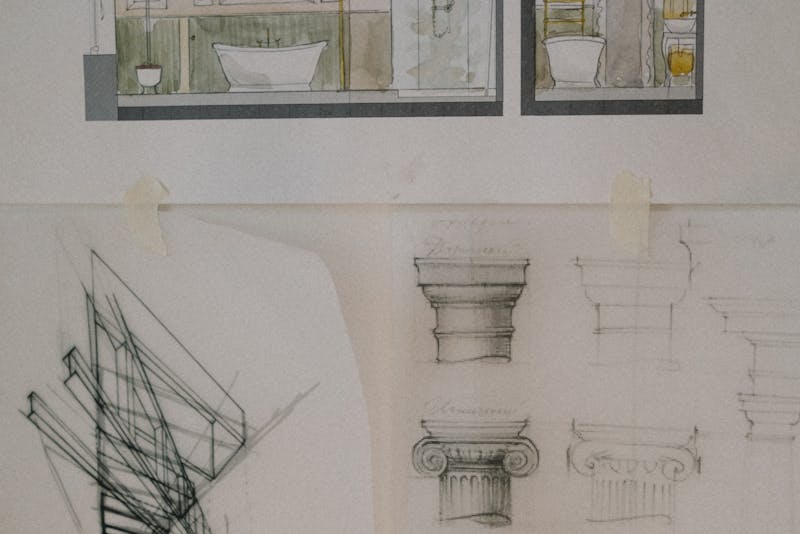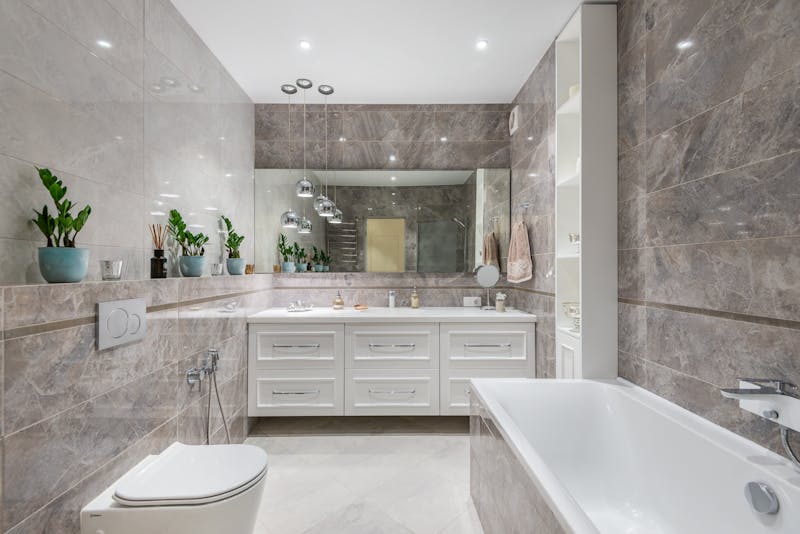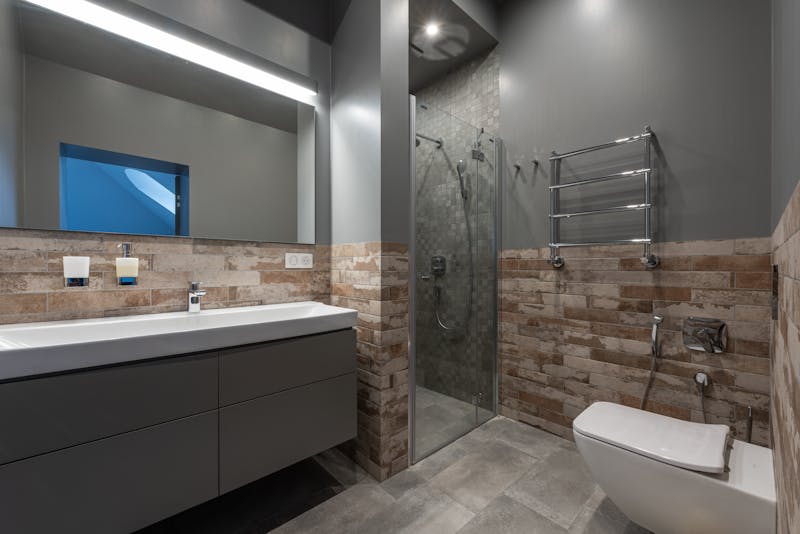- Bathroom remodels typically take 3–8 weeks, but larger or more complex projects can last 10–12 weeks.
- Planning and design are crucial; finalizing layouts, materials, and budgets early helps prevent delays.
- Permits, material lead times, and inspections can significantly affect the timeline.
- Demolition, plumbing, electrical work, and tiling are the most time-consuming phases.
- Delays often result from last-minute design changes, material shortages, or unforeseen structural issues.
- Keeping the existing layout and choosing in-stock materials can help speed up the remodel.
- Clear communication with contractors and proactive preparation ensure a smoother renovation experience.
Bathroom remodeling remains one of the most rewarding home improvement projects for homeowners who want to upgrade comfort, boost property value, and modernize outdated spaces. Yet one of the most common questions that comes up before starting any renovation is: How long does it take to remodel a bathroom? The truth is that timelines vary significantly depending on the bathroom’s size, the scope of work, the materials you choose, and how well the project is planned.
Understanding these schedules helps homeowners set realistic expectations, prevent unnecessary delays, and minimize day-to-day stress as the work progresses.
This in-depth guide walks you through the entire remodeling timeline—from pre-planning to final inspections. Whether you’re doing a simple refresh or a full teardown, you’ll know exactly what to expect, how long each phase takes, and what factors can extend or shorten your project.
Why Bathroom Remodeling Timelines Vary
Before diving into the week-by-week timeline, it’s important to understand why no two bathroom remodels run on the exact same schedule. Homeowners often assume that a bathroom renovation is a straightforward project, but it actually involves multiple trades, synchronized tasks, material lead times, and building standards that vary by location.
A bathroom remodel may be considered minor or extensive depending on how much of the existing structure remains untouched. Projects that involve plumbing changes, electrical rewiring, or rebuilding walls naturally take more time than cosmetic updates. Lead times for tiles, fixtures, and specialty finishes can extend your schedule further, especially if you choose custom materials. Contractor availability and permit requirements can also influence timelines, making early planning essential.
This section will help you understand what drives a remodel’s duration so you can better anticipate the process, coordinate with professionals, and avoid unnecessary delays.
Key factors that affect the timeline:
- Size of the bathroom
- Whether plumbing or electrical systems are being moved
- Scope of demolition
- DIY involvement vs. hiring multiple contractors
- Condition of the existing bathroom
- Permit approval times
- Availability of materials and labor
- Number of design changes during the project
How Long Does It Take to Remodel a Bathroom? (Typical Timeline Explained)
A standard bathroom remodel generally takes 3 to 8 weeks, but larger or more complex projects can extend to 10–12 weeks. The timeline below covers a full remodel from start to finish. Each section outlines what happens and how long it usually takes, so you can plan and prepare accordingly.
Planning, Budgeting, and Design Phase (1 to 3 Weeks)

Before any physical work begins, homeowners need time to plan, research, and establish a realistic budget. This phase sets the foundation for a smooth project and helps prevent schedule-disrupting surprises.
During this stage, you will finalize your design vision, review bathroom layout options, and determine which materials and fixtures to use. Many homeowners underestimate how long this step takes because they assume decisions can be made quickly. However, comparing prices, checking product lead times, and evaluating multiple design concepts often require time.
In addition, this stage may involve consulting contractors, discussing your desired timeline, and identifying potential structural or plumbing limitations. Proper planning ultimately helps reduce delays as the project progresses.
What usually happens during this phase:
- Define your desired design style
- Decide on fixtures, tiles, lighting, and cabinetry
- Obtain initial estimates and finalize the budget
- Consult with contractors and schedule start dates
- Order materials with long lead times
- Work with designers or remodelers to refine layout plans
Permits, Measurements, and Ordering Materials (1 to 4 Weeks)
This phase plays a major role in determining how quickly your bathroom remodel progresses. Depending on your local building codes and the scope of your renovation, certain permits may be required—especially for electrical updates, plumbing relocation, or structural changes.
Measurements and material ordering also happen here. Delays in product delivery can stall the entire remodel, making it essential to order items early. Homeowners who choose custom vanities, stone surfaces, or imported tiles should expect longer wait times.
A well-prepared contractor will help coordinate permits, schedule inspections, and track shipment dates to avoid unnecessary project downtime.
Common tasks completed during this stage:
- Site assessment and precise measurements
- Permit applications
- Ordering tiles, fixtures, cabinets, and plumbing components
- Waiting for permit approvals
- Scheduling demolition and construction dates
Demolition Phase (1 to 3 Days)
With permits approved and materials on the way, contractors can begin dismantling your existing bathroom. This stage is fast but noisy and messy. Although demolition typically takes only a few days, surprises behind the walls—such as mold, rot, or outdated plumbing—can add time.
Homes with older plumbing systems or water damage may require additional repairs before new installations can begin. Your contractor will inform you immediately if these issues arise, and the timeline may extend depending on the severity.
This phase includes:
- Removing old fixtures, cabinets, and countertops
- Tearing out tiles, flooring, and wall surfaces
- Inspecting plumbing and electrical lines
- Cleaning and prepping the area for construction
Structural, Plumbing, and Electrical Work (3 to 7 Days)
This stage is essential for ensuring the bathroom is safe, functional, and up to code. Any changes to plumbing or electrical systems must be completed before walls are closed and fixtures are installed. Homeowners updating a shower layout or adding outlets should expect extra time in this stage.
Once all mechanical work is completed, inspections may be required before the renovation proceeds. Passing inspections ensures the project continues smoothly and prevents costly fixes later.
Common tasks during this stage:
- Rough-in plumbing for showers, sinks, and toilets
- Rough-in electrical for lighting, outlets, and ventilation
- Framing walls or niches, if needed
- Installing new insulation
- Conducting required inspections
Installing Walls, Drywall, and Flooring (3 to 5 Days)
After the mechanical work receives approval, contractors begin rebuilding the bathroom’s structure. Installing drywall, putting up moisture-resistant barriers, and laying new flooring all contribute to forming your new bathroom environment.
Drywall installation can take time because it involves hanging boards, applying joint compound, and allowing it to dry before sanding. Proper drying and curing times are vital to prevent cracking or moisture issues later.
This stage often includes:
- Installing moisture-resistant drywall
- Applying joint compound and sanding
- Adding waterproofing membranes
- Installing flooring such as tile or vinyl
- Preparing surfaces for tile installation
Tiling, Shower Installation, and Waterproofing (5 to 10 Days)
Tile work is one of the most time-consuming phases of a bathroom remodel, especially if you choose intricate patterns, small mosaic tiles, or custom designs. Waterproofing the shower area, installing backer boards, and ensuring proper slope for drainage all contribute to the timeline.
Once tiles are installed and grouted, they must dry completely before fixtures can be mounted. Attempting to speed up this stage can lead to structural issues or premature tile failure, so patience is essential.
Tasks in this phase:
- Installing shower pans or bases
- Applying waterproof membranes
- Setting wall and floor tiles
- Grouting and sealing surfaces
- Allowing tiles to cure before the next phase
Installing Cabinets, Fixtures, and Features (3 to 5 Days)
This is when the bathroom truly begins to look like its finished form. Cabinets, vanities, lighting fixtures, and plumbing fixtures are installed carefully to avoid damaging the newly tiled walls and floors.
Homeowners typically get excited during this phase because they can finally see how their design choices come together. Minor adjustments may be needed to ensure proper alignment and functionality.
This stage includes:
- Installing vanities and cabinets
- Mounting mirrors and lighting
- Setting toilets, faucets, and shower fixtures
- Hooking up plumbing and testing connections
- Adding finishing hardware and accessories
Final Touches, Painting, and Cleanup (2 to 4 Days)

To complete the remodel, contractors focus on cosmetic details and tidy up the space. Minor imperfections are repaired, walls are painted, and the entire area is cleaned to reveal your new bathroom. Final touches may also include installing trim, caulking gaps, or sealing surfaces.
Once everything is polished and functional, a final inspection is performed—either by the homeowner or a local inspector, depending on permit requirements.
Final tasks usually involve:
- Painting walls or touch-ups
- Caulking around fixtures
- Inspecting plumbing and electrical work
- Cleaning debris and dust
- Performing walkthroughs and final adjustments
Common Delays and How to Avoid Them
Even with a well-organized timeline, bathroom remodels are prone to delays. Being aware of potential issues can help you plan proactively and minimize disruptions. Timely communication with contractors, clear design decisions, and early ordering of materials greatly improve the chances of staying on schedule.
Understanding where delays typically occur allows you to prepare strategically and avoid extended downtime.
Common causes of delays:
- Long material lead times
- Design changes mid-project
- Permit approval delays
- Discovery of structural issues
- Contractor scheduling conflicts
Ways homeowners can stay on schedule:
- Finalize all materials before construction begins
- Avoid last-minute design changes
- Hire reliable, experienced contractors
- Ensure clear communication throughout the project
- Schedule work during seasons with stable contractor availability
How to Speed Up Your Bathroom Remodel Timeline
Not all homeowners want to wait 6 to 8 weeks for a remodel to finish. With smart planning and the right team, you can significantly shorten the timeline. However, speeding up a remodeling project should never come at the cost of quality workmanship or long-term durability.
This section highlights practical methods that can reduce downtime without compromising craftsmanship. From pre-ordering materials to minimizing structural changes, these tips will help you achieve a faster result while keeping stress levels manageable.
Practical strategies include:
- Keeping the existing layout to avoid plumbing changes
- Choosing in-stock materials instead of custom orders
- Hiring a full-service contractor instead of multiple subcontractors
- Preparing the space before construction starts
- Ensuring quick decision-making during unexpected issues
Conclusion: What to Expect from Your Bathroom Remodel Timeline
Remodeling a bathroom is a major home improvement project that requires planning, coordination, and realistic expectations. While the typical renovation takes anywhere from 3 to 8 weeks, the exact timeline depends on the complexity of the project, material availability, and the efficiency of your contractor. By understanding each stage of the process—from planning and demolition to installation and finishing—you can make informed decisions that keep your remodel on schedule.
Homeowners who prepare early, avoid unnecessary design changes, and work with experienced professionals can enjoy a smoother remodel experience and a beautiful finished space that adds comfort and long-term value to their home.
